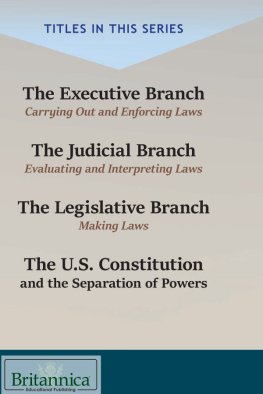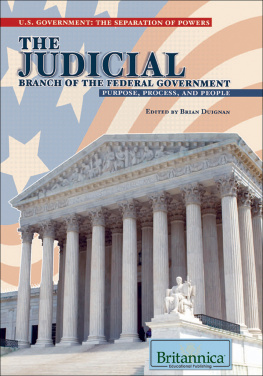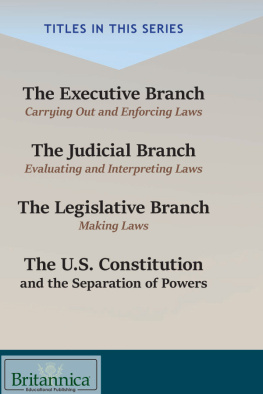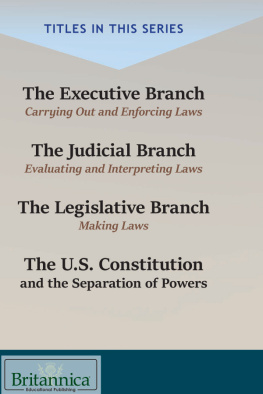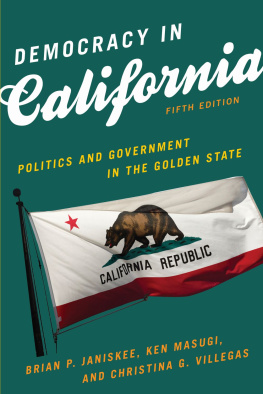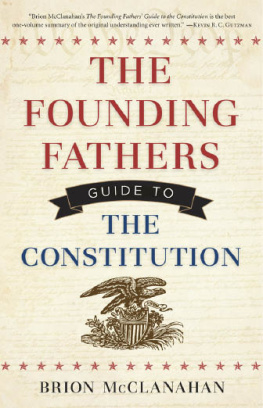Brian Duignan - The Legislative Branch of the Federal Government
Here you can read online Brian Duignan - The Legislative Branch of the Federal Government full text of the book (entire story) in english for free. Download pdf and epub, get meaning, cover and reviews about this ebook. year: 2009, publisher: Britannica Educational Publishing, genre: Politics. Description of the work, (preface) as well as reviews are available. Best literature library LitArk.com created for fans of good reading and offers a wide selection of genres:
Romance novel
Science fiction
Adventure
Detective
Science
History
Home and family
Prose
Art
Politics
Computer
Non-fiction
Religion
Business
Children
Humor
Choose a favorite category and find really read worthwhile books. Enjoy immersion in the world of imagination, feel the emotions of the characters or learn something new for yourself, make an fascinating discovery.
- Book:The Legislative Branch of the Federal Government
- Author:
- Publisher:Britannica Educational Publishing
- Genre:
- Year:2009
- Rating:3 / 5
- Favourites:Add to favourites
- Your mark:
- 60
- 1
- 2
- 3
- 4
- 5
The Legislative Branch of the Federal Government: summary, description and annotation
We offer to read an annotation, description, summary or preface (depends on what the author of the book "The Legislative Branch of the Federal Government" wrote himself). If you haven't found the necessary information about the book — write in the comments, we will try to find it.
The Legislative Branch of the Federal Government — read online for free the complete book (whole text) full work
Below is the text of the book, divided by pages. System saving the place of the last page read, allows you to conveniently read the book "The Legislative Branch of the Federal Government" online for free, without having to search again every time where you left off. Put a bookmark, and you can go to the page where you finished reading at any time.
Font size:
Interval:
Bookmark:

(a trademark of Encyclopdia Britannica, Inc.)
in association with Rosen Educational Services, LLC
29 East 21st Street, New York, NY 10010.
and the Thistle logo are registered trademarks of Encyclopdia Britannica, Inc. All
rights reserved.
All rights reserved.
For a listing of additional Britannica Educational Publishing titles, call toll free (800) 237-9932.
Michael I. Levy: Executive Editor
Marilyn L. Barton: Senior Coordinator, Production Control
Steven Bosco: Director, Editorial Technologies
Lisa S. Braucher: Senior Producer and Data Editor
Yvette Charboneau: Senior Copy Editor
Kathy Nakamura: Manager, Media Acquisition
Brian Duignan: Senior Editor, Religion and Philosophy
Hope Lourie Killcoyne: Senior Editor and Project Manager
Nelson S: Art Director
Matthew Cauli: Designer
Introduction by Richard Worth
p. cm.(U.S. government: the separation of powers)
In association with Britannica Educational Publishing, Rosen Educational Services.
ISBN 978-1-61530-067-9 (eBook)
1. United States. Congress. 2. Legislative powerUnited States. 3. LegislatorsUnited
StatesHistory. 4. LegislatorsUnited StatesBiography. I. Duignan, Brian.
K1021.L45 2010
328.73dc22








Font size:
Interval:
Bookmark:
Similar books «The Legislative Branch of the Federal Government»
Look at similar books to The Legislative Branch of the Federal Government. We have selected literature similar in name and meaning in the hope of providing readers with more options to find new, interesting, not yet read works.
Discussion, reviews of the book The Legislative Branch of the Federal Government and just readers' own opinions. Leave your comments, write what you think about the work, its meaning or the main characters. Specify what exactly you liked and what you didn't like, and why you think so.


